Viola ampelous: features, planting and care
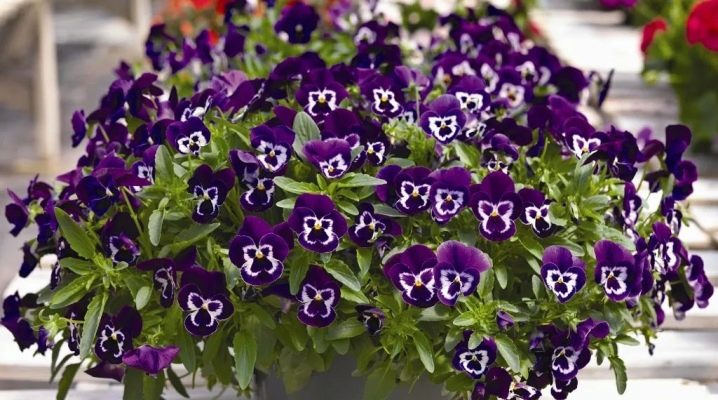
There are a number of reasons explaining the high popularity of the ampelous viola. In addition to a spectacular appearance that meets the expectations of most aesthetes, it can boast of ease of planting and undemanding care, which is primarily important for novice florists. Also noteworthy are the many varieties of the presented ornamental plant, each of which has its own remarkable features.

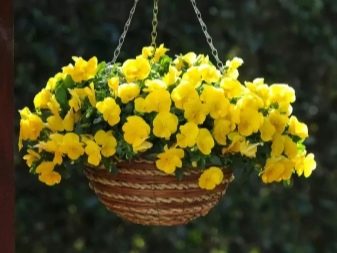


Description
The name of the described viola is of German origin, indicating the specificity of its cultivation (in Germany, "ampels" are called hanging flower vases). Like other members of the violet family, it is most often cultivated as an annual or biennial, and subject to certain conditions, it can delight its owners much longer.
The main features of the plant in question are listed below:
- spherical bush;
- average length of shoots (from 40 to 60 cm);
- flowers of the same type, the diameter of which reaches 4–5 cm or more (the specific value depends on the variety);
- the average height of the bush is 20 cm;
- relatively narrow leaves, shaped like an egg or oval;
- flowering period - from spring to the first frost;
- the color is bright, represented by one or more tones.


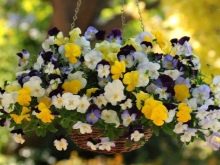
At first, the ampelous viola develops in a vertical direction, but gradually its shoots begin to fall (most often this happens at the beginning of flowering). Given this circumstance, it is advisable to grow the described violet in hanging pots, decorative pots or baskets.
Due to its excellent appearance, said plant can become a real decoration of flower beds and alpine slides, balconies and loggias. Worth mentioning are other pluses of the ampelous violet - endurance, which allows it to withstand sudden temperature changes, and rapid development, which ensures flowering after 14-15 weeks from the moment of planting.

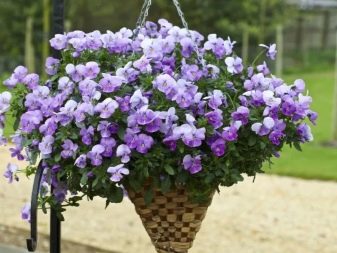
Varieties
To date, breeders have bred many variations of the ampelous viola, which have excellent decorative qualities. If we highlight the most remarkable varieties of this plant, then their list will look like this.
- "Waterfall mix F1". Despite its sophisticated appearance, the violet in question can boast of excellent cold resistance. It branches well, the length of its lashes reaches 40 cm, and its white, yellow, lilac and purple flowers grow up to 5 cm in diameter.

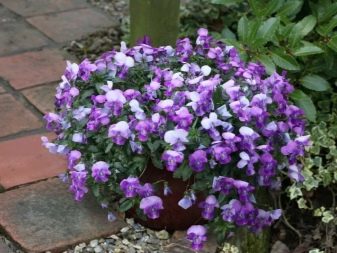
- "Summer wave purple." The main feature of this viola is its high growth energy, one of the manifestations of which is the impressive length of the lashes (up to 75 cm). Another advantage of the variety is delicate purple flowers, the diameter of which reaches 5-6 cm.
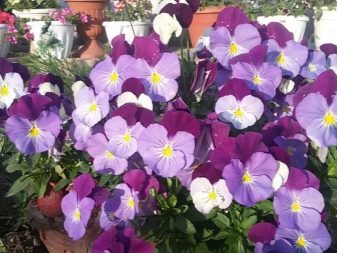
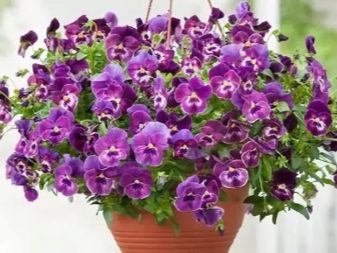
- "Plenschief F1 lavender blue"... The mature bushes of the described plant look like a solid ball of flowers, decorated with purple, lilac and white petals. The endurance of the presented variety is also noteworthy, allowing it to painlessly tolerate frosts down to -7 ° C.
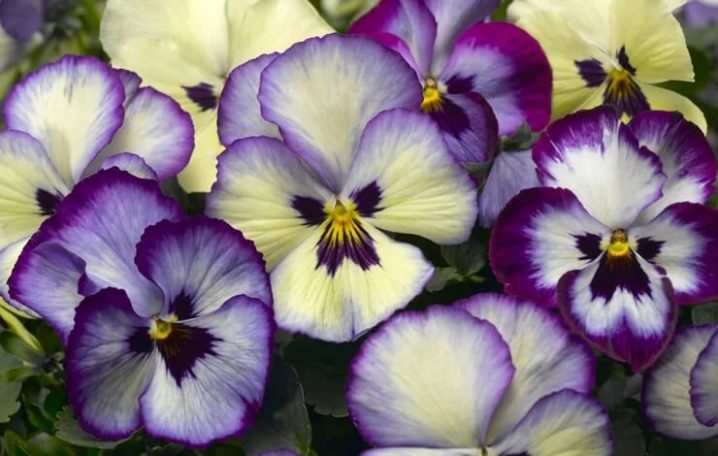
- Wonderfall Blue Picoty Shades. This ampelous violet is interesting for its large flowers, the color of which suggests the presence of two basic tones - white and purple. As for the length of the whips, in the representatives of this variety it is relatively small (around 30 cm).
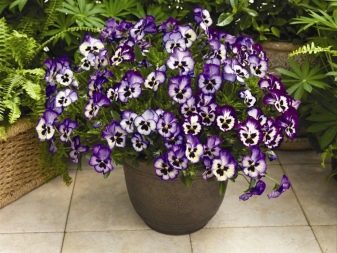
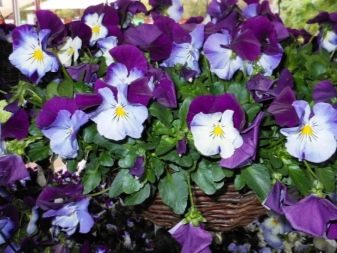
- "Black Waterfall"... One of the most spectacular ampelous violas, a distinctive feature of which are dark purple flowers, reaching 5 cm in diameter. Another feature of this violet is its beautiful foliage, which has a rich green color.
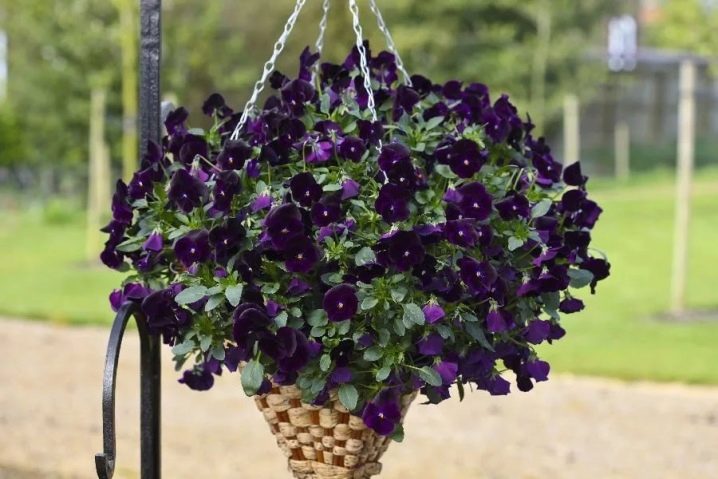
- Cool Wave... Representatives of this variety are characterized by very developed shoots (up to 75 cm) and a large number of flowers of various colors. Despite the impressive length of the lashes, the height of an adult plant is 15–20 cm, which is barely up to the average value for ampel violets.
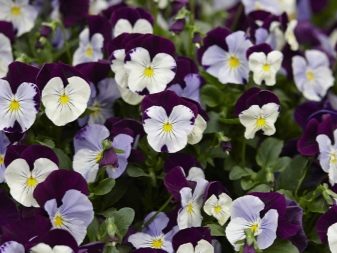
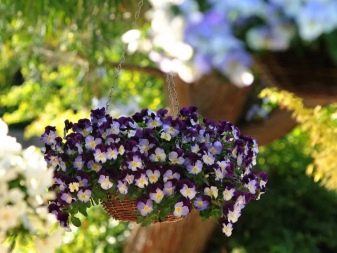
- "Golden waterfall"... A distinctive feature of the viola in question is a lot of yellow flowers, organically combined with bright and dense greenery. Also, the plant is characterized by relatively short shoots, the length of which rarely exceeds the 30-centimeter mark.
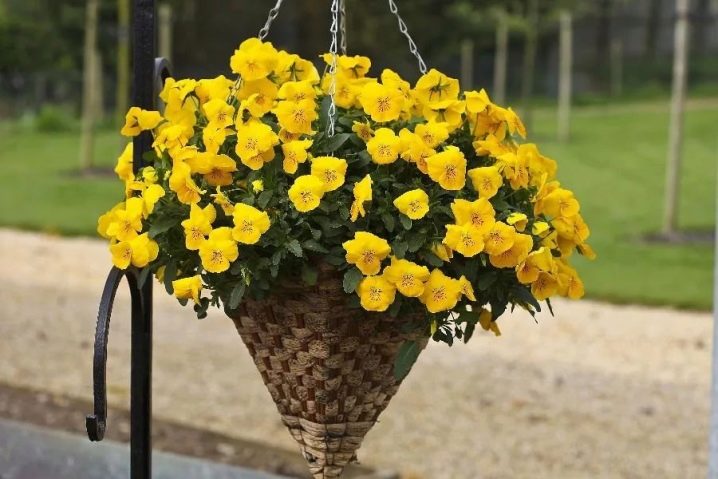
- Pansy F1 Diana Lavender. This violet is notable for its abundant and early flowering. Its upper petals are colored lilac, while the rest are white with purple shadows and a slight yellow spot.

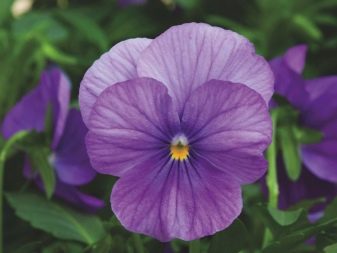
- Pearl Waterfall. The presented variety is characterized by a long and very effective flowering. The average length of the shoots of adult plants is 30 cm. The flowers attract attention with their pearl-violet color, which creates a spectacular combination with bright green foliage.

Worthy of separate mention ampel viola "Butterfly-fashionista", yellow-purple flowers of which reach 8 cm in diameter. With such an ornament, it looks very elegant, which is confirmed by the vast majority of its owners.
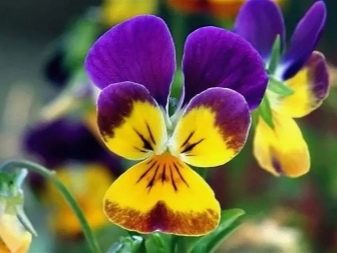
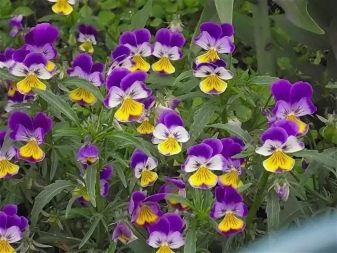
Sowing seeds
For growing ampel violets from seeds, a variety of containers with sufficient area are suitable. As for the substrate, it is possible to use nutritious and loose soils that retain moisture well. One example of a suitable primer is a mixture, which includes garden soil, peat and humus (the optimal proportion is 2: 1: 1).
If the owner of viols wants to grow them as annuals, he should start sowing seeds in the second half of winter.
An alternative option is the cultivation of ampelous violets as biennials, the beginning of which must be postponed to the first half of the summer.
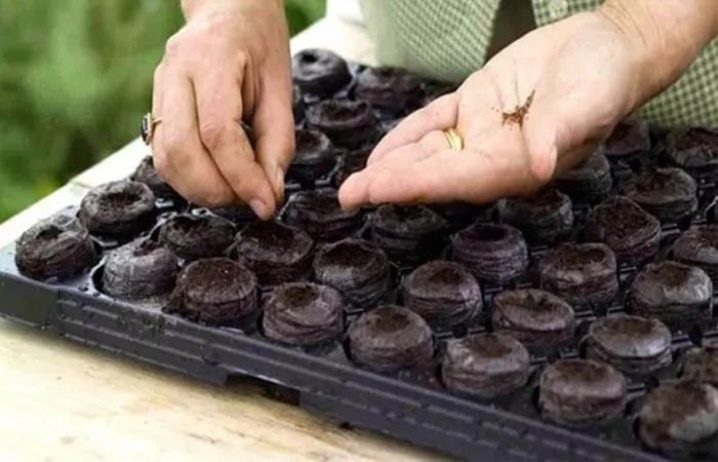
There are three ways to sow the seeds of the plant in question.
- With instillation. This method involves preparing grooves that are 5 mm deep and spaced 10 mm apart. In each of them, it is necessary to place seeds, observing a step of 10 to 20 mm. Further, the planting material must be covered with soil, watered thoroughly, covered with a transparent film and transferred to a dark room with room temperature. In order to avoid the development of pathogenic microflora, it is advisable to ventilate the soil twice a day, removing the “shelter” for 10-15 minutes.
- Surface. The described technique allows you to achieve a faster emergence of shoots (shoots do not need to break through the soil layer). To do this, water the soil with warm water, carry out the marking in accordance with the previously mentioned gap and distribute the planting material over the surface of the substrate. The further sequence of actions does not differ from the one given above.
- Combined. This method provides for following the algorithm described in the previous paragraph, up to and including the distribution of seeds over the surface of the substrate. Here, the planting material is sprinkled with a thin layer of soil (up to 2 mm), after which the sequence of actions common to all methods is adhered to.
In most cases, seedlings appear after a decade from the day of sowing. If the seeds are covered with too dense soil, this time interval increases by 2–3 times.
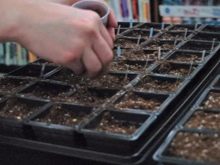
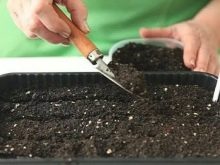
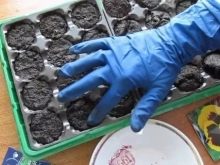
After emergence, the container should be exposed to light as long as possible. (the best option is from 12 to 14 hours a day). If there is not enough lighting, it makes sense for the plant owner to use phytolamps.
Despite the endurance of the seedlings of the described viola, experts advise to accustom them to fresh air gradually, daily increasing the duration of airing. It is possible to remove the film immediately, but this will complicate the adaptation of young plants to the changed conditions of keeping.
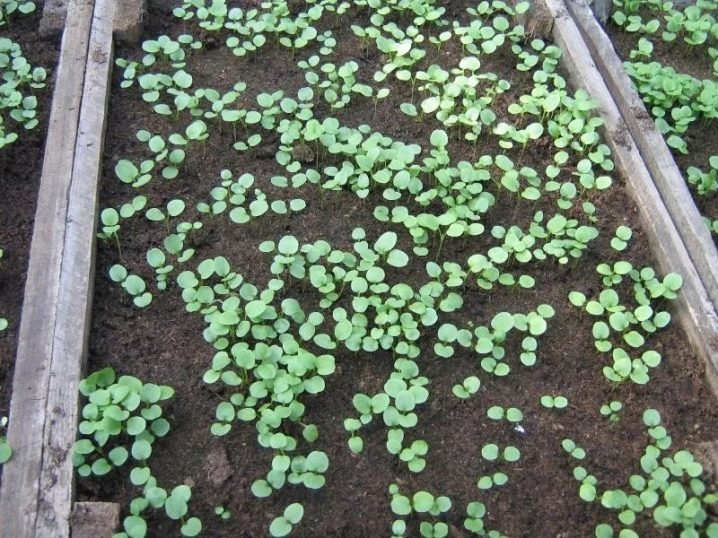
Pick and drop into the ground
You can start picking seedlings after the seedlings acquire two real leaves. To solve this problem, it is permissible to use both separate containers up to 10 cm in diameter and a common box (the distance between young plants in this case should be 6 cm). When performing a dive, it is worth paying attention to deepening the sprouts of the ampelous viola - a procedure to avoid their collapse. In the future, when the number of pairs of real leaves increases to three, the tops must be carefully pinched (this contributes to the tillering of violets).
The planting of young plants in a permanent place begins in May, when the threat of spring frosts has passed. If the viols are grown at home on a glassed-in balcony or loggia, this procedure can be carried out as early as March.
Tanks intended for viols are pre-disinfected using a weak solution of potassium permanganate. As for the volume required for the full development of ampel violets, it is 1-2 liters for each plant.
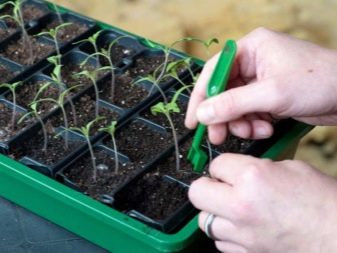
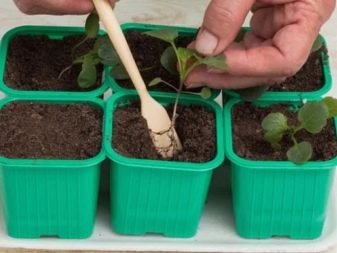
The further sequence of actions of the grower looks like this:
- make holes in the soil 6–7 cm deep (if there are several plants per container, the minimum distance between them should be 15 cm);
- place expanded clay, broken brick or other drainage material at the bottom of the holes (the recommended layer is 2 cm);
- arrange young plants in the holes (you need to plant with the preservation of an earthen coma);
- cover the seedlings with soil and water them thoroughly under the root.
In addition, experts do not advise to strongly compact the soil around the ampel viols - in order to avoid problems with the supply of oxygen to the roots.
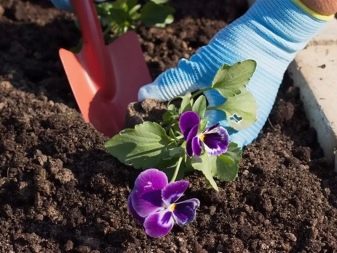

How to care?
To grow a healthy and beautiful ampelous violet, she needs to provide care, which involves taking into account the following simple rules.
- Both direct light and diffused light are suitable for the plant in question (in the first case, it blooms more abundantly, but for a shorter duration). If ampelous viola is grown in a hot region, being in the midday sun is contraindicated for it.
- The optimum temperature for the described violet is in the range of 10-25 ° C. She does not tolerate heat well, which often leads to interruptions in flowering. At the same time, short-term cold snaps up to 3-5 ° C and even lower (depending on the variety) do not harm it.
- Watering the ampelous viola should be daily and abundant, but not excessive. This means that the drying out of the earthy coma cannot be allowed, but it is also not worth pouring the plant into it.
- Throughout the entire growing season, the ampelous violet must be fed with mineral fertilizers - superphosphate or ammonium nitrate (the recommended dosage is 30 g per sq. M). The optimal frequency of such procedures is every 2 decades.
- If the flowers of the violet become smaller, and the lashes turn yellow and dry, she needs pruning, which involves shortening the stems in half. In some situations, when the plant has completely lost its decorative effect, it is radically renewed, leaving 5-6 cm of the length of the shoots (it is important that they have leaves).
- One of the main enemies of ampelous viola are fungal diseases, which most often develop in conditions of high humidity. The fight against them involves the removal of the affected areas and the treatment of plants with a broad-spectrum fungicide.

In addition, it is worth paying attention to regular loosening of the soil and removal of weeds, preventing the full development of the plant in question.
Observing these recommendations, every florist can achieve the optimal result - both very experienced and with a minimum set of skills.
How to plant and care for the ampelous viola, see below.





































































































Thanks for the interesting information.
The comment was sent successfully.